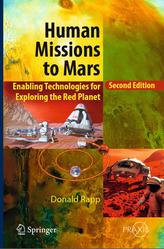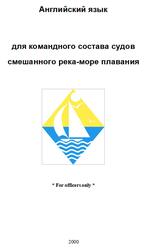Human Missions to Mars, Enabling Technologies for Exploring the Red Planet, Rapp D., 2008.
Human missions to Mars represent the pinnacle of solar system exploration for the next half-century. In addition to providing a means of exploring Mars, such missions would represent an inspiring engineering achievement and create a new era of expansion of humanity into space. Because such missions would require a major technological effort as well as very large expenditures, they remain for the moment as futuristic concepts embodied in paper studies by visionaries, advocates, and enthusiasts.

Long-Term Evolution of Water on Mars.
Several papers in the literature deal with the question of how a presumed initial endowment of ground ice on Mars may have evolved over several billion years of exposure to the atmosphere through porous regolith. However, all of these models suffer from our lack of knowledge regarding the Mars environment over billions of years.
Smoluchowski (1968) used a model that assumed that a layer of ice 10 m thick, protected by an upper layer of thickness L meters, existed 10 years ago, and he proceeded to estimate the rate of sublimation as function of L, porosity and grain size. From these results, he concluded that for sufficiently low porosity and small grain size, subsurface ice could persist for 109 years when protected by layers of thickness of several meters or more.
Contents.
1 Why Explore Mars?.
1.1 Introduction.
1.2 Robotic Exploration—The Establishment View.
1.3 The Curmudgeons’ View on the Search for Life on Mars.
1.4 Why Send Humans to Mars?—The Enthusiasts’ View.
1.5 Sending Humans to Mars—The Skeptic’s View.
References.
2 Planning Space Campaigns and Missions.
2.1 Campaigns.
2.2 Planning Space Missions.
2.3 Architectures.
2.4 A Mission as a Sequence of Steps.
2.5 What’s Delivered to the Destination?.
2.6 What’s in Low Earth Orbit.
2.7 What’s on the Launch Pad?.
2.8 IMLEO Requirements for Space Missions.
References.
3 60+ Years of Humans to Mars Mission Planning.
3.1 Von Braun’s Vision.
3.2 Earliest NASA Concepts.
3.2.1 First Studies.
3.2.2 Studies in the Early 1960s.
3.2.3 Nuclear Rocket Development.
3.2.4 The Boeing Study of 1968.
3.3 Early Mars Planning Exterior to NASA.
3.3.1 The Planetary Society and the SAIC Analysis.
3.3.2 The Case for Mars II.
3.4 NASA in the Late 1980s.
3.4.1 LANL.
3.4.2 Sally Ride Study.
3.4.3 SAIC.
3.4.4 Office of Exploration Case Studies (1988).
3.4.5 Office of Exploration Case Studies (1989).
3.4.6 The Space Exploration Initiative and Its Successors.
3.4.7 LANL.
3.5 Independent Studies of the 1990s.
3.5.1 The Soviets.
3.5.2 Mars Direct.
3.5.3 The Mars Society Mission.
3.6 The Pre-DRM Era.
3.7 NASA Design Reference Missions 1993–2007.
3.7.1 Design Reference Mission-1 (DRM-1).
3.7.2 Design Reference Mission-3 (DRM-3).
3.7.3 Mass Comparisons: DRM-3 and DRM-1.
3.7.4 ISRU System for DRM-3.
3.7.5 Design Reference Mission-4 (DRM-4).
3.7.6 Dual Landers Mission.
3.7.7 Design Reference Architecture-5 (DRA-5).
3.7.8 Exploration Strategy Workshop (2006).
3.8 Other Mars Mission Concepts.
3.8.1 Team Vision Approach to Space Exploration.
3.8.2 The MIT Study.
3.8.3 ESA Concurrent Design Facility Study (2003).
3.8.4 HERRO Missions to Mars Using Telerobotic Surface Exploration from Orbit.
3.8.5 Boeing in the 21st Century.
3.8.6 Free Return Missions.
3.8.7 Short Stay Versus Long Stay Missions.
3.8.8 Architectures Based on Flyby and Free Return Trajectories.
3.9 Recent NASA Activities.
References.
4 Getting There and Back.
4.1 Propulsion Systems.
4.1.1 Propellant Requirements for Space Transits.
4.1.2 The Rocket Equation.
4.1.3 Dry Mass of Rockets.
4.2 Trajectory Analysis.
4.2.1 Rocket Science 101.
4.2.2 Mars Mission Duration and Propulsion Requirements.
4.2.3 More Realistic Models.
4.3 Earth to Low Earth Orbit.
4.4 Departing from LEO.
4.4.1 The Δv Requirement.
4.4.2 Mass Sent Toward Mars.
4.4.3 Nuclear Thermal Rocket for TMI.
4.4.4 Solar Electric Propulsion for Orbit Raising.
4.5 Mars Orbit Insertion.
4.6 Ascent from the Mars Surface.
4.7 Trans-Earth Injection from Mars Orbit.
4.8 Earth Orbit Insertion.
4.9 Gear Ratios.
4.9.1 Introduction.
4.9.2 Gear Ratio Calculations.
4.9.3 Gear Ratio for Earth Departure.
4.10 LEO to Mars Orbit.
4.11 LEO to the Mars Surface.
4.12 IMLEO for Mars Missions.
4.12.1 Chemical Propulsion and Aero-Assist.
4.12.2 Use of Nuclear Thermal Propulsion.
4.12.3 Use of ISRU.
References.
5 Critical Mars Mission Elements.
5.1 Life Support Consumables.
5.1.1 Consumable Requirements (Without Recyling).
5.1.2 Use of Recycling Systems.
5.2 Radiation Effects and Shielding Requirements.
5.2.1 Radiation Sources.
5.2.2 Definitions and Units.
5.2.3 Radiation Effects on Humans and Allowable Dose.
5.2.4 Radiation in Space.
5.2.5 Radiation Levels in Mars Missions.
5.2.6 Radiation Summary.
5.3 Effects of Microgravity.
5.3.1 Introduction to Generic Effects of Zero g.
5.3.2 Reviews of Low-g Effects.
5.3.3 Artificial Gravity.
5.3.4 NASA Plans for Low-g Effects.
5.4 Human Factors in Confined Space.
5.5 Abort Options and Mission Safety.
5.5.1 Abort Options and Mission Safety in ESAS Lunar Missions.
5.5.2 Abort Options in Mars Missions.
5.5.3 Acceptable Risk.
5.6 Habitats.
5.6.1 Habitat Design and Human Factors.
5.6.2 Terrestrial Analogs of Mars Habitats.
5.6.3 DRM-1 Habitats.
5.6.4 DRM-3 Habitats.
5.6.5 Dual Landers Habitat.
5.6.6 SICSA Habitat Designs.
5.6.7 Other Habitat Concepts.
5.7 Aero-Assisted Orbit Insertion and Entry, Descent and Landing.
5.7.1 Introduction.
5.7.2 Experience with Robotic Spacecraft.
5.7.3 Entry Descent and Landing Requirements for Human Missions to Mars.
5.7.4 Precision Landing.
5.7.5 Development, Test and Validation Roadmaps.
References.
6 In Situ Utilization of Indigenous Resources.
6.1 Value of ISRU.
6.2 Lunar ISRU.
6.2.1 Introduction.
6.2.2 Ascent Propellants.
6.2.3 Life Support Consumables.
6.2.4 Propellants Delivered to LEO from the Moon.
6.2.5 Propellants Delivered to Lunar Orbit for Descent (and Ascent).
6.2.6 Regolith for Radiation Shielding.
6.2.7 Visionary Concepts.
6.2.8 Lunar Resources and Processes.
6.2.9 Cost Analysis for Lunar ISRU.
6.3 Mars ISRU.
6.3.1 Introduction.
6.3.2 Timeline for ISRU on Mars.
6.3.3 Mars ISRU Products.
6.3.4 Mars ISRU Processes.
6.3.5 Power Requirements of a Mars ISRU System.
6.3.6 Reduction in IMLEO from Use of ISRU in Human Mission to Mars.
6.4 Fueling Mars-Bound Vehicles from Extraterrestrial Resources.
6.4.1 Lunar Resources.
6.4.2 Value of Lunar Water in LEO.
6.4.3 Percentage of Water Mined on the Moon Transferred to LEO.
6.4.4 Near-Earth Object Resources.
6.5 Lunar Ferry for Lunar Descent Propellants.
6.6 Staging, Assembly and Refueling in Near-Earth Space.
6.6.1 Orbiting Fuel Depots.
6.6.2 On-Orbit Staging.
6.7 Transporting Hydrogen to Mars.
6.7.1 Terrestrial Versus Space Applications.
6.7.2 Storage of Hydrogen in Various Physical and Chemical States.
6.7.3 Boil-off in Space.
6.7.4 Transporting Hydrogen to Mars and Storing It There.
6.7.5 Summary and Conclusions.
References.
7 Why the NASA Approach Will Likely Fail to Send Humans
to Mars for Many Decades to Come.
7.1 The Moon-Mars Connection.
7.1.1 Differences Between Lunar and Mars Missions.
7.1.2 The Moon as a Means of Risk Reduction for Mars.
7.1.3 ISRU as a Stepping Stone from Moon to Mars.
7.2 Characteristics of the Mars Campaign.
7.3 Destination-Driven Versus Constituency-Driven Programs.
7.4 Need for New Technology.
7.5 NASA Technology Roadmaps.
7.6 Space Science Enterprise (SSE).
7.6.1 SSE Scope of Technology.
7.6.2 Lead Centers.
7.6.3 SSE Technology Summary.
7.7 Human Exploration Technology.
7.7.1 Technology for Human Exploration at NASA.
7.7.2 Dramatic Changes in the Last Decade.
7.8 Future Prospects.
7.8.1 Constraints.
7.8.2 Clarifying Mars Mission Options.
7.8.3 Fundamental Needs.
7.9 Does NASA HEO Have the Needed Mentality?.
7.10 Conclusions.
References.
Appendix A: Solar Energy on the Moon.
Appendix B: Solar Energy on Mars.
Appendix C: Water on Mars.
Glossary.
Index.
Бесплатно скачать электронную книгу в удобном формате, смотреть и читать:
Скачать книгу Human Missions to Mars, Enabling Technologies for Exploring the Red Planet, Rapp D., 2008 - fileskachat.com, быстрое и бесплатное скачивание.
Скачать pdf
Ниже можно купить эту книгу, если она есть в продаже, и похожие книги по лучшей цене со скидкой с доставкой по всей России.Купить книги
Скачать - pdf - Яндекс.Диск.
Дата публикации:
Теги: учебник по английскому языку :: английский язык :: Rapp
Смотрите также учебники, книги и учебные материалы:
Следующие учебники и книги:
 University Rankings, Macleans Canadas Best Schools, Masse K., 2018 — Technology, health, energy, the economy engineers make a difference in all aspects of everyday life. McMaster Engineering faculty and students … Книги по английскому языку
University Rankings, Macleans Canadas Best Schools, Masse K., 2018 — Technology, health, energy, the economy engineers make a difference in all aspects of everyday life. McMaster Engineering faculty and students … Книги по английскому языку A contrastive grammar of english and arabic, Khalil A.M., 1999 — This book is a contrastive study of English and Arabic at the phonological, morphological and syntactic levels. It is intended … Книги по английскому языку
A contrastive grammar of english and arabic, Khalil A.M., 1999 — This book is a contrastive study of English and Arabic at the phonological, morphological and syntactic levels. It is intended … Книги по английскому языку Italian At a Glance, Foreign Language Phrasebook and Dictionary At a Glance Series, Costantino M., 2018 — So you’re taking a trip to one of the many fascinating countries of the world. That’s exciting! This phrase book, … Книги по английскому языку
Italian At a Glance, Foreign Language Phrasebook and Dictionary At a Glance Series, Costantino M., 2018 — So you’re taking a trip to one of the many fascinating countries of the world. That’s exciting! This phrase book, … Книги по английскому языку New Zealand English grammar, fact or fiction, Hundt M., 1998 — New Zealand English (NZE), like Canadian, South African and Australian English, belongs to those national varieties of English that are … Книги по английскому языку
New Zealand English grammar, fact or fiction, Hundt M., 1998 — New Zealand English (NZE), like Canadian, South African and Australian English, belongs to those national varieties of English that are … Книги по английскому языку
Предыдущие статьи:
 How to Make Masks, Good J., 2012 — It’s just as much fun to make a mask as it is to wear it after it’s finished. And remember … Книги по английскому языку
How to Make Masks, Good J., 2012 — It’s just as much fun to make a mask as it is to wear it after it’s finished. And remember … Книги по английскому языку How Students Think When Doing Algebra, Rhine S., Harrington R., Starr C., 2019 — This book is the result of a multi-year project to synthesize research on algebraic thinking from the past 35 years … Книги по английскому языку
How Students Think When Doing Algebra, Rhine S., Harrington R., Starr C., 2019 — This book is the result of a multi-year project to synthesize research on algebraic thinking from the past 35 years … Книги по английскому языку Hey friends 3, Student book, Foster F., Brown B. — Фрагмент из книги. The Death Valley is one of the hottest places In the world. It has got the record … Книги по английскому языку
Hey friends 3, Student book, Foster F., Brown B. — Фрагмент из книги. The Death Valley is one of the hottest places In the world. It has got the record … Книги по английскому языку Grammar Practice, Grades 1-2, Clutterbuck P., 2011 — This first book of Grammar Practice for first and second grades provides teachers with resources, activities, and ideas aimed at … Книги по английскому языку
Grammar Practice, Grades 1-2, Clutterbuck P., 2011 — This first book of Grammar Practice for first and second grades provides teachers with resources, activities, and ideas aimed at … Книги по английскому языку




